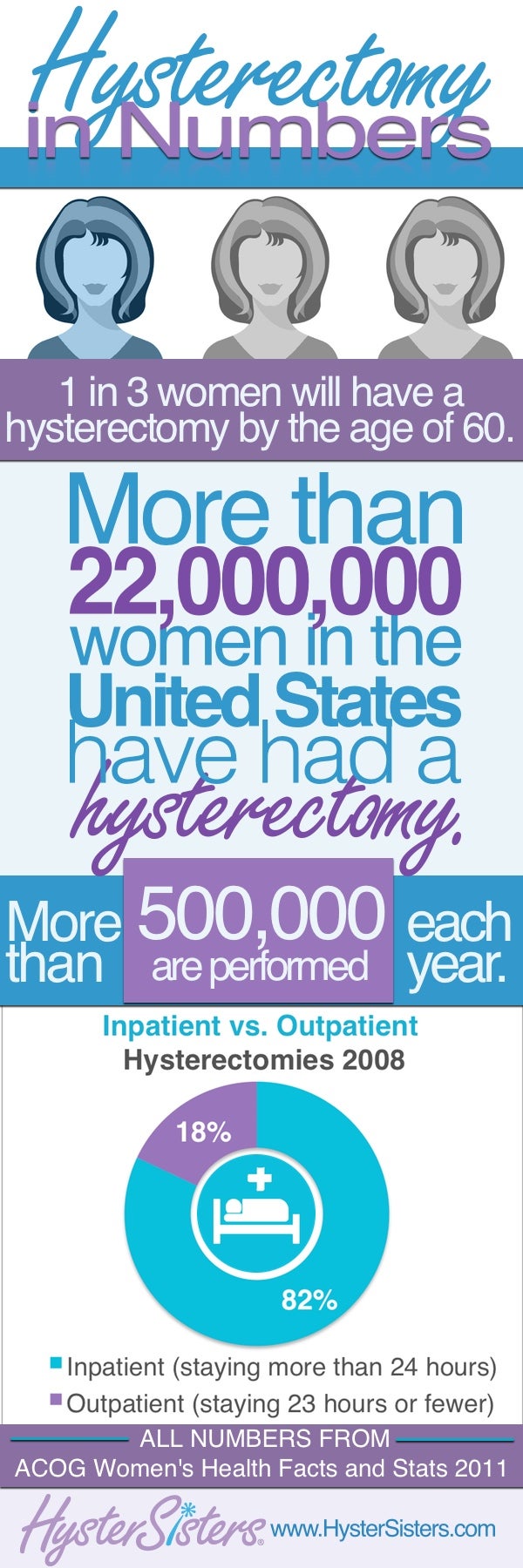Basic Numbers from the United States
From WomensHealth.gov:
- Hysterectomy is the 2nd-most common surgery among women.
- 22,000,000+ women have had a hysterectomy.
From ACOG 2011 Women’s Health Stats:
- 33.3% will have a hysterectomy by the age of 60.
- 500,000+ hysterectomies are performed every year.
- 18% of all hysterectomies in 2008 were performed as outpatient surgeries.
- Fibroids accounted for 44% of hysterectomies in 2000 and 31% in 2008.
- 4.7 per 1,000 women have hysterectomy in South and Midwest.
- 3.9 per 1,000 have hysterectomy in Northeast.
HYSTERECTOMY TYPES IN THE UNITED STATES
From the National Institutes of Health:
- Among 518,828 hysterectomies in a 2005 Nationwide Inpatient Sample, 14% were laparoscopic, 64% abdominal, and 22% vaginal.
- The odds of laparoscopic compared with abdominal hysterectomy were higher in the West than in the Northeast.
- Women older than 35 years are more likely to have an abdominal hysterectomy.
- Women with low income, Medicare, Medicaid, or no health insurance are more likely to have either a vaginal or abdominal hysterectomy rather than laparoscopic.
Hysterectomy Poll - Harris - February 2015
We polled* more than 2,000 Americans to learn their awareness of hysterectomy and their attitudes toward communicating about their health conditions. Sample questions included “what happens during the procedure known as a hysterectomy?” and “have you or someone you know had the procedure known as a hysterectomy?” We also wanted to learn how comfortable Americans are with discussing their health conditions with friends, doctors and via the Internet, such as social media accounts.
How familiar are Americans with the procedure known as hysterectomy?
- Almost half (44 %) of Americans are incorrect or do not know what procedure a hysterectomy is.
- 29 % guessed incorrectly and 16 % saying they were not at all sure. The incorrect response that one in four (25 %) Americans selected was the removal of the ovaries. Fewer selected the removal of the appendix, breasts, or gall bladder (1 % each) and less than 1 % selected the removal of the kidneys or tonsils. 1 % said a hysterectomy was something else.
- Adults ages 18-34 (29 %) are significantly more likely than those ages 35-44 (17 %) to say they are not at all sure what a hysterectomy is.
- Women are more likely than men to answer correctly – 64% vs. 47%, respectively.
- Men are more likely than women to have said they were not at all sure – 22% vs 10%, respectively.
- More than half of U.S. adults know someone who has had a hysterectomy, with women being more likely than men to know someone who has had the procedure.
Read the entire Hysterectomy Harris Poll Results.
Additional Information
Did you know:
- Women report feelings – “from here to there”
When it comes to having a hysterectomy, women report a wide range of feelings: Some are devastated. Some are ashamed. Some feel like they have let themselves or their spouse down. Some feel less than a woman. Some feel liberated. Some are thrilled. - Women report experiencing a sense of loss
Many women feel a sense of loss–-no matter what their age, no matter if they have a child or not, no matter if they thought they never wanted to have children. They feel a loss of possibility, a loss of choice. - Hysterectomies often a quality of life choice
Only 10% of all hysterectomies are for cancer. A small percentage is for emergency following childbirth. Many hysterectomies are considered a quality of life choice – an elective surgery. - Less time in Hospital
Stays in the hospital are shortening for a hysterectomy because more and more women are opting for minimally invasive surgery. About 20% of all patients go home the same day of their surgery. - HysterSisters reports changing hysterectomy surgery types
In 2003, 14.3% of HysterSisters members reported having laparoscopic surgery for their hysterectomy. In 2014, 53.8% members report having a laparoscopic surgery. In 2003, HysterSisters members reported numbers reflecting the national abdominal hysterectomy statistics of 60%. In July 2014, however, the numbers reflected a much smaller percentage of 28.8%.





